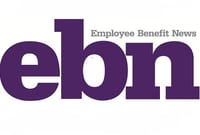 As has happened so many times before, the Baby Boomer generation is once again drawing attention to an unmet need: a seamless way to consolidate their collection of retirement accounts into a single account, which is a necessary step to creating a sturdy retirement plan. Much has been written about how sponsors can improve both their plans’ overall health and their participants’ retirement outcomes by embracing roll-ins; nonetheless, the account-consolidation process remains time-consuming and expensive for most participants.
As has happened so many times before, the Baby Boomer generation is once again drawing attention to an unmet need: a seamless way to consolidate their collection of retirement accounts into a single account, which is a necessary step to creating a sturdy retirement plan. Much has been written about how sponsors can improve both their plans’ overall health and their participants’ retirement outcomes by embracing roll-ins; nonetheless, the account-consolidation process remains time-consuming and expensive for most participants.
According to a 2015 Boston Research Technologies study of mobile workforce behaviors, the roll-in process takes an average of five to six weeks from beginning to end. Some participants have to wait longer—13% responded that their roll-in took one to two months to complete, and 27% stated the process lasted over two months.
On average, participants expect they have to devote 19 hours of personal time to a roll-in, according to the study, which found that 20% of participants expect the process to require more than 19 hours of their time. The value of those hours is high—the study found that 36% of participants value personal time devoted to the roll-in process at between $100 and $500, while 8% valued this time at between $1,000 and $5,000 and 6% assigned it a value of over $5,000.
Not surprisingly, the study found that 32.8% of participants left their savings in their prior-employer plan when they changed jobs. Given the time (and money) they would have to devote to rolling their balances into their current-employer plans, stranding savings is the most cost-effective option for many participants.
However, there is a simple fix to this dilemma—which presents sponsors with a great opportunity to demonstrate their value as fiduciaries to participants, as well as strengthen their plans and the U.S. retirement system as a whole. All sponsors have to do is offer roll-in assistance to participants as a group benefit (a service provided by their plan).
The Boston Research Technologies study found that 62% of participants who undertook a roll-in received help from another party, and 46% of participants think of roll-in assistance as “an excellent benefit” compared to other benefits they receive (an additional 47% perceive it as “a good benefit” compared to others).
Even better news for sponsors is that most participants would pay virtually any price to take advantage of an employer-facilitated roll-in service. According to the study, 29% of participants are “very likely” (and an additional 34% are “somewhat likely”) to pay any fee for an employer-provided roll-in service in which nearly all the work is handled by a specialist. If a sponsor offered the service for free, 53% of participants would “very likely” utilize it. In fact, the study found that if the plan sponsor paid for a facilitated roll-in service, 85% of participants would roll their IRAs into their 401(k) accounts.
Participants who move their retirement savings to their new-employer plans when they change jobs, and in general stay invested in the U.S. retirement system for their entire working lives, end up saving more for retirement than counterparts who cash out or leave accounts in prior-employer plans.
Enabling seamless portability, including auto portability for participants with account balances under $5,000, is a good start toward helping more participants reach the top tier of savers prepared for retirement. By simply offering roll-in assistance as a group benefit (or at no cost), sponsors can facilitate account consolidation and reduce cash-outs among a wider spectrum of participants—and, ultimately, significantly increase their plans’ average account balances.
- Home
- Individuals
- Auto Portability
- Plan Sponsors
- The Small Account Problem
- RCH Portability Services
- Plan Sponsor Support
- The Missing Participant Problem
- What is a Missing Participant?
- Why Plan Sponsors Should be Concerned
- What Causes Missing Participants?
- The Magnitude of the Problem
- What Regulations Apply to Missing Participants?
- Sources of Uncertainty for Plan Sponsors
- Best Practices for Finding Missing Participants
- What to Look For in a Search Service
- Learn More About Missing Participants
- RCH's Missing Participant Search Service
- Terminating 401(k) Plans
- Participant Testimonials
- Due Diligence Material
- Contact Us
- Accountholders
- Company
- News & Information
- Login
